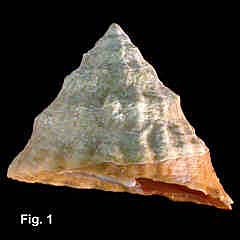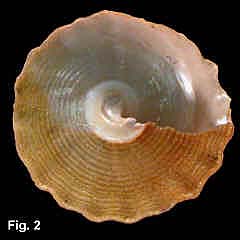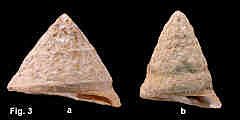|
|
|
|
|
Astralium tentoriiformis (Jonas, 1845) Description: Shell height less than width; ratio of height to width 0.75-0.90. Whorls sharply angled, sometimes weakly keeled, keel angled downwards; periphery irregularly scalloped by axial nodules or extended into rounded spines, particularly on juvenile shells. Base flat or concave. Sculptured with any of three components, each variable in strength, but usually eroded: (1) granular spiral threads (2) elongate nodules on lower half of whorls, about 20 on last whorl (3) fine or coarse growth ridges parallel to the aperture lip. Base with fine, scaly riblets, apertural callous on base more than half of whorl in mature shells. Outer lip thin, simple. Exterior white, grey, fawn or reddish-brown; interior nacreous. Operculum calcareous, white with purple or blue areas. Size: Up to 59 mm high, commonly about 30 mm. Distribution: Endemic to Australia: Mackay, Queensland, to eastern Victoria. Habitat: In exposed positions on rocky shores, in lower intertidal and shallow subtidal zone. Common. Comparison: Usually larger and taller than A. squamiferum, with nodules on the lower half of the whorls, the base concave, and the operculum with blue or purple markings. (See A. squamiferum for figure of operculum) Synonymy: Has been known as Astrea sirius (Gould, 1849), based on a misidentification (Ponder, 1975). Remarks: Juvenile specimens show the same ratio of height to width as adults, but have the peripheral spines more pronounced, largely through not being eroded. Figs. 1,2: Woody Head, Iluka, NSW (C.076502) Fig. 3: a. Bottle and Glass Rocks, Port Jackson, NSW (C.445613) b. Caloundra, Queensland (C.064757) |


